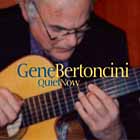Home » Jazz Articles » Album Review » Gene Bertoncini: Quiet Now
Gene Bertoncini: Quiet Now
In a career spanning forty years and a large discography that includes stints with Wayne Shorter, Paul Desmond, Hubert Laws, and Astrud Gilberto, Gene Bertoncini has focused his attention on the nylon-string guitar. With a soft-spoken personality that translates directly to his approach on the instrument, Bertoncini's personal discography may be relatively small, but it's remarkably consistent. The majority of his own recordings have been small group works—most, in fact, are duos with his long-time musical partner, bassist Michael Moore. But the solo Quiet Now follows up on another beautiful solo release, '00's Body and Soul, once again demonstrating his gently orchestral approach and ability to create a programme that is easy on the ears but never lacking in substance.
Unlike Breau, whose staggering virtuosity made him sound like more than one person playing at once, Bertoncini's approach is more straightforward. Perhaps less overtly impressive on a technical level but never less than elegantly lyrical, Bertoncini quietly and unassumingly explores a surprising breadth of material that places Coltrane, Evans, and Strayhorn alongside Schumann and Puccini in a programme that still manages to feel stylistically unified.
One of Bertoncini's greatest strengths is his ability to create medleys of tunes that might seem like strange bedfellows, but ultimately join together beautifully. While putting together Strayhorn's "Lush Life and "Isfahan may seem like less of a stretch, combining Coltrane's "Giant Steps with Tadd Dameron's "On a Misty Night appears odd indeed on first glance. And yet both share a similar opening melody, and so by taking "Giant Steps at a slow pace, with the melody first stated on the bass strings before being reiterated on the top strings in a more recognizable fashion, the transition to "On a Misty Night becomes completely seamless.
While Bertoncini's playing feels effortless, the attention he pays to creating contrapuntal harmonic movement belies a deeper mind at play. His schooling in architecture transfers to his musical endeavours in terms of an inner sense of logic and design. And while some architects create visually complex and arresting structures, if Bertoncini's music is any indication, it would suggest that his would have been designs of deceptive simplicity and grace.
There's nothing jagged about Quiet Now, but Bertoncini's refined imagination and allegiance to a song's melody makes for an experience that is never less than fulfilling. Rich without being overpoweringly lush, sweet without being saccharine, sentimental without being maudlin, Quiet Now's title says it all.
Visit Gene Bertoncini on the web.
Track Listing
Lush Life/Isfahan, My One and Only Love, Giant Steps/On a Misty Night, Traumerei, So in Love/The More I See You, Olha Maria, Quiet Now, Nessun Dorma, Waltz for Debbie/Very Early, Theme from
Personnel
Gene Bertoncini
guitarGene Bertoncini (Buscarino acoustic guitar)
Album information
Title: Quiet Now | Year Released: 2005 | Record Label: Ambient Records
< Previous
Is There A New Mainstream?
Next >
Sunday Mornin'
Comments
Tags
For the Love of Jazz
 All About Jazz has been a pillar of jazz since 1995, championing it as an art form and, more importantly, supporting the musicians who create it. Our enduring commitment has made "AAJ" one of the most culturally important websites of its kind, read by hundreds of thousands of fans, musicians and industry figures every month.
All About Jazz has been a pillar of jazz since 1995, championing it as an art form and, more importantly, supporting the musicians who create it. Our enduring commitment has made "AAJ" one of the most culturally important websites of its kind, read by hundreds of thousands of fans, musicians and industry figures every month.




















